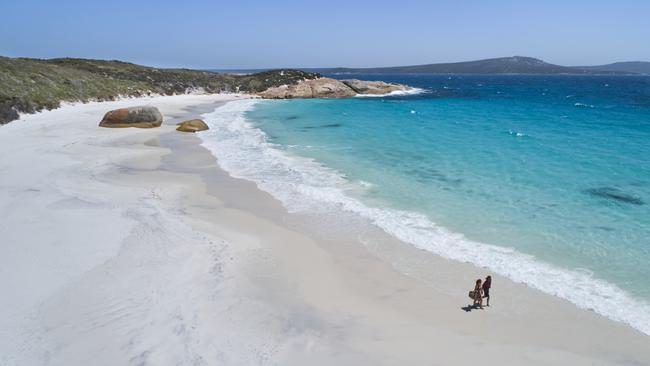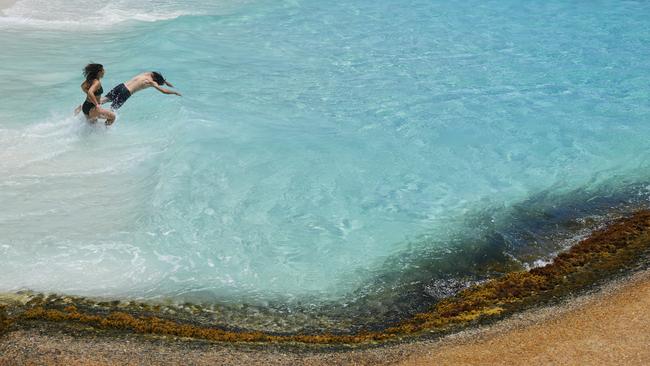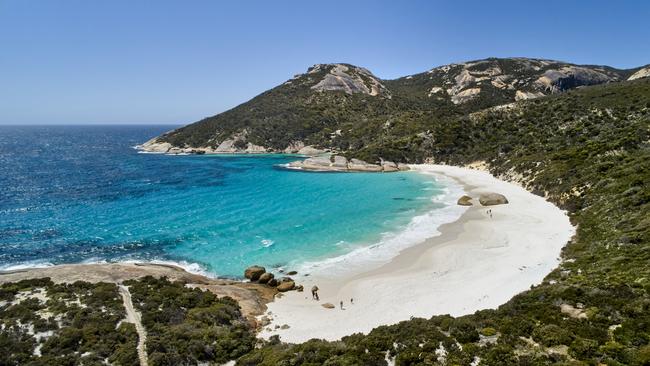Two Peoples Bay: my deep dive into a southwest ancestral jewel
It’s a beautiful bay with a fascinating past – but there’s another reason this writer will never forget this amazing place.

The fishing hook in my sister’s nose was bright silver, and bright were the drops of blood too. I think my errant cast put the hook there, though it may have been hers. We both threw lines and they got tangled and… now she was screaming. Dad cut the line. My sobbing sister held the hook against the pain. There must have been an outboard motor because I remember a roaring rush from Sinker Reef back to main beach at Two Peoples Bay.
That bright steel hook in my sister’s nostril is not really the first thing that comes to mind when I think of Two Peoples Bay, 30km east of Albany. Although it’s on the south coast of Western Australia, the bay faces east and is sheltered by two massive granite headlands. A couple of hundred metres offshore there’s a big, flat rock that only the generous would call an island.
Behind this rock – at another time and when we were all even younger – my father sat in the same borrowed and battered aluminium dinghy. Dangling a line in the water, he’d heard what he absently thought were gulls screaming. He woke from his ocean reverie and began to row back to shore, whereupon he saw my mother running to and fro in the shallows. The screaming was not birds, it was her. Unable to swim, she was splashing, screaming, pointing out to sea. Next, my father saw the bubble of my shorts among the ripples and shifting waves. Tearing off his rubber boots and heavy jumper, he dived in. He used to say that the thump of my body as he threw me back into the boat made him think he’d killed me there and then.
I’d been wading along a small creek that ran from a spring among the dunes and into the ocean. There’d been rain, and the cold, tan water made my feet seem darker. I remember thinking they could have belonged to someone else, some other me. The water became a little deeper, and then sand was dissolving beneath my feet and suddenly I was looking up from inside the ocean’s surface. I thrust my legs against the ocean floor and rose for one quick breath, sank again. Tried to run along the sand bottom and saw bubbles rise above my head. I thrust my legs again to snatch another breath. Three times, just like in the movies; and then at seven years of age I breathed in salt water and resigned myself to dying. I woke in the hospital nearly two days later with mum and dad beside the bed pouring love and attention over me. Just me. I thought I was perhaps in heaven.
Embarrassingly, I only recently realised that three of my novels feature a drowning scene.

Two Peoples Bay is beautiful. Thedunes swaddle you in the pungent smell of heather and peppermint, and granite boulders both shield you from the wind and warm your cold flesh with the memory of sun. Somewhere near the perimeter of attention you hear the swell slamming against rock, see the wind lifting sand grains in sunlight and sense how even granite erodes and diminishes in the pooling of time.
The name of the bay apparently dates to 1803, when the crews of American and French whaling ships met there, although of course they were, at best, the third and fourth peoples to know the place. Another time a ship reported its landing party tossed their tools aside and fled from a gigantic snake rearing its head above the trees near a spring close to the beach.
The Noongar man Nebinyan was born at Two Peoples Bay. He composed a long song-cycle about the “whale-hunt” based on his experience in the 19th century’s ephemeral shore-based whaling workforce. Indigenous people were 40 per cent of that workforce. An anomaly: they were paid equally, or so the accounts say.
In 1901, when he was an old man, Nebinyan showed the perpetually curious Daisy Bates, a student of Aboriginal culture, a dance that our people had added to their repertoire after Matthew Flinders’ visit 100 years before. Flinders’ party had found respite a short distance west of Two Peoples Bay in the even more sheltered waters of Princess Royal Harbour. Grateful for Noongar hospitality, Flinders had his marines perform a military drill by way of thank you. The drill became a dance.

Today, Princess Royal Harbour is increasingly known by its Noongar name Mamang Koort – whale heart. The name comes from an “ocean song-line” featuring a man and a whale travelling to Albany from further east along the south coast. It’s a language artefact that resides in place like no other can, and includes the “whale-road” the sailing ships joined as they arrived.
The bay is also known for the rediscovery of two animals thought extinct – the Noisy Scrub Bird and Gilbert’s Potoroo. It is a haven for quokkas, once abundant across south-western Australia, and became a nature reserve after that inveterate twitcher, Prince Philip, heard the call of the Noisy Scrub Bird when he visited in the 1960s. The beach shacks littering the peppermint trees were subsequently demolished.
I remember visiting those shacks. It must have been around the time of my near drowning. We’d been invited by a man my father knew from the Main Roads Department. The shack-owner was a surveyor, or perhaps an engineer, and my father was leading hand of a “gang” that included several other Noongar workers. A baby cousin was with us. When the milk bottle shattered, someone attached its teat to an empty beer bottle. The guffawing at baby and bottle made me uncomfortable even then.
The sand squeaks under your feet at Two Peoples Bay, and there’s much I might add but – solipsistic as ever – I mainly think of Two Peoples Bay as that place where I drowned and then came back.
Kim Scott has twice won the Miles Franklin Literary Award, for Benang and That Deadman Dance. His most recent novel, Taboo (Picador Australia), is set in his ancestral Noongar country in WA’s Great Southern region. He lives in Perth.





To join the conversation, please log in. Don't have an account? Register
Join the conversation, you are commenting as Logout